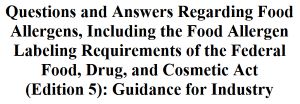By Reed Mangels, PhD, RD
In January 2025 the U.S. Meals and Drug Administration (FDA) launched a 27-page doc that gives up to date steerage for business on labeling of allergens.
One query which this doc addresses is “Are proteins from main meals allergens, produced from different sources by way of the usage of genetic engineering and different applied sciences, topic to the meals allergen labeling necessities of the FD&C Act?” The FDA states that “meals elements that embrace proteins derived from a serious meals allergen (e.g. , by way of chemical, biochemical, mechanical, fermentation, or bioengineering processes) could also be able to eliciting an allergic response, and their presence will not be apparent with out declaration of the allergen.” They supply an instance of utilizing a genetically engineered pressure of yeast to supply a protein equivalent (or very related) to the protein in cow’s milk. A product with this protein in it must be labeled to point that it comprises “milk” (FDA’s phrase for milk from cows, goats, sheep, or different ruminants). The FDA additionally says that “further info could also be useful in some circumstances to make the supply ingredient clear, equivalent to ‘Accommodates milk-derived protein,’…”
The FDA acknowledges milk, eggs, fish, Crustacean shellfish, tree nuts, peanuts, wheat, soybeans, and sesame as the main meals allergens.
One other query that this doc addresses is whether or not a product or ingredient that’s derived from a serious meals allergen however that doesn’t comprise the allergenic protein will need to have a meals allergen label. For instance, ghee which has been processed in order that it doesn’t comprise milk protein or lactose (milk sugar) which doesn’t comprise milk protein. If an ingredient is derived from a serious meals allergen and doesn’t comprise protein, it’s not topic to allergen labeling necessities. The ingredient, equivalent to ghee, or lactose would nonetheless must be listed on the label however wouldn’t should be recognized as “(milk)” or “comprises milk.” The FDA notes that residual protein is usually current in milk-derived elements, so producers would wish to display that an ingredient doesn’t comprise milk protein in an effort to keep away from having to adjust to allergen labeling necessities.
Spice blends that comprise components derived from a serious meals allergen should declare the allergen on the label. For instance, a product label may say “spices (wheat)” or “Accommodates: Wheat.”
Allergen labeling necessities apply to human meals and dietary dietary supplements however to not pet meals, animal feeds, prescription or over-the-counter medicine, cosmetics, or cleansing merchandise.
The FDA states {that a} steerage doc, such because the one mentioned right here, doesn’t “set up legally enforceable duties” and “must be seen solely as suggestions until particular regulatory or statutory necessities are cited.”
This put up comprises my private understanding of the FDA’s steerage and shouldn’t be construed, seen, or used as authorized recommendation on product labeling to adjust to this steerage.
Reference
U.S. Meals and Drug Administration. Questions and Solutions Concerning Meals Allergens, Together with the Meals Allergen Labeling Necessities of the Federal Meals, Drug, and Beauty Act (Version 5): Steering for Business. https://www.fda.gov/media/117410/obtain. 2025.


